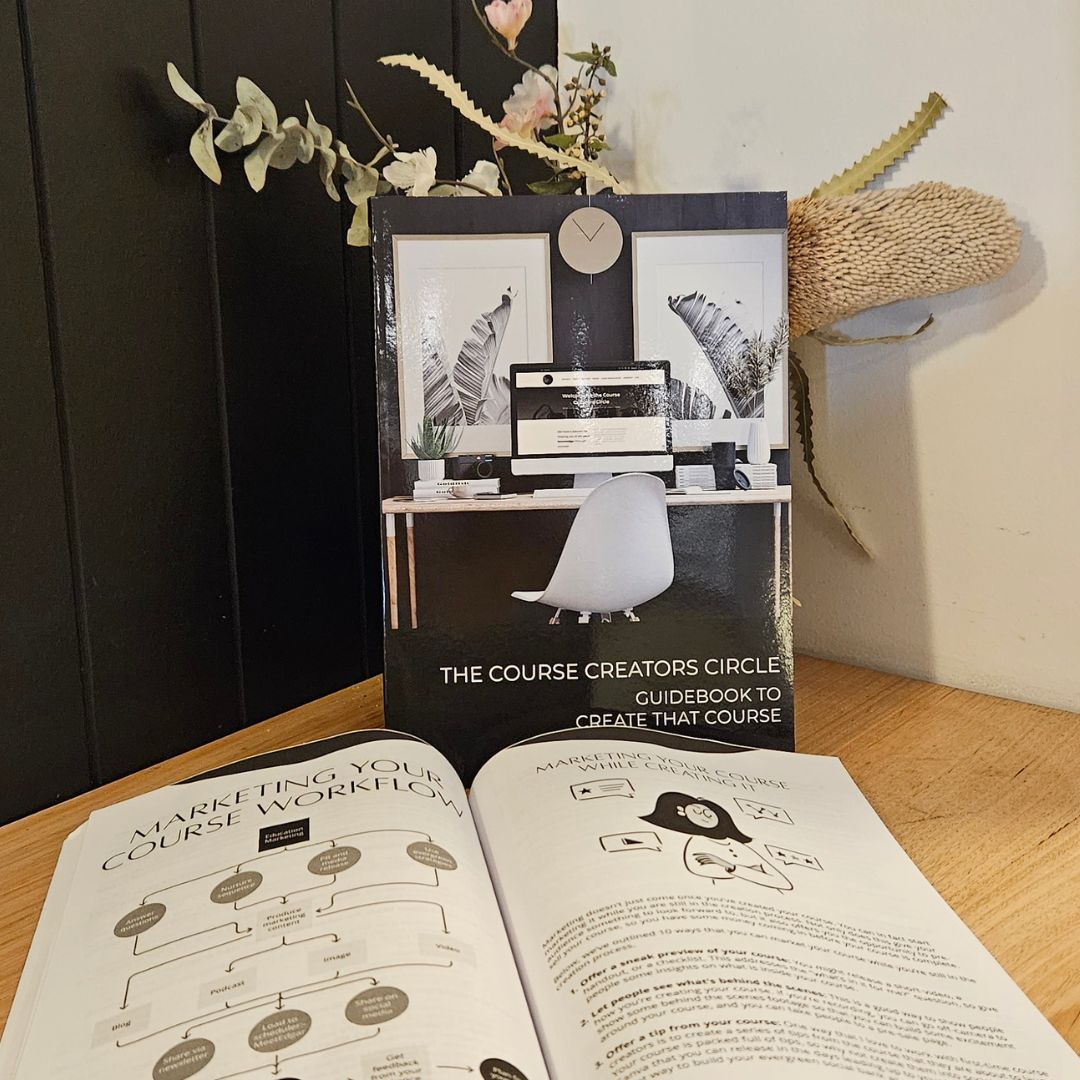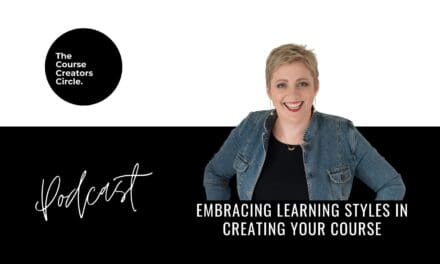The different stages of course creation go through a process, and successful course creators spend time and effort researching and planning their course content before they produce it to ensure their courses meet students’ expectations and allow them to learn and get a win from the course.
Along these stages, there are a few little gremlins that kick into your thoughts, and they are the feeling of overwhelm and being not good enough to teach. Remember, our people want to learn from us so we just need to breathe a little and break down those overwhelming steps.
So, here we are sharing with you our recommended process for course creation based on best practices and principles that we’ve developed in-house and with our clients. To get a complete resource of the course creation process, check out The Course Creation Guidebook and The Course Creators Circle Hub and get all the tools, tips & checklists to help you kickstart your course.
Stages in the Course Creation Process
Stage 1: What do you want to teach?
The first stage of the course creation process is figuring out what you want to teach and whether that course is going to be right for you and your business. Essentially, this is the research phase of course creation. This is where you are going to research your topic thoroughly.
Tools like AnswerThePublic is an excellent source to see what people are typing into search. You might want to poll your existing people and ask what they want to learn about. You want to make sure that you’re finding the right audience for the course you want to create as well as understanding who these audiences are and where they hang out online on social media.
Stage 2: Choose the right platform for your courses
The next stage is choosing the right platform to host your courses. This stage is also where you decide whether you are hosting your course on your website or an external platform. I host my courses on an external platform because my web development team advised me that the volume of students that would come through would create problems for my website, so it’s good to stick with a focused LMS platform.
Personally, I’m a Thinkific Expert, so I’m going to naturally suggest Thinkific, but there are a lot of other course platforms available in the market right now. I have a 30-day FREE trial if you want to check out Thinkific Pro. If you use the link, you also get some extra bonus information from Thinkific about how to use and create your platform.
Once you’ve researched your topic though, the platform of your choice is going to teach you how to set up your course, how to deliver your content, and how to get paid.
Another platform to make sure you have is a mailing platform like Mailerlite for your email sequences that will nurture your audience through enrolling to your course.
Stage 3: Planning your modules
The third stage in the course creation process is to draft your course outline and plan your modules. Start to look at what’s going to be included in each module, each lesson, what workbooks you need, and the materials that you need for the course.
Our Course Planning Sheets would be able to help you with drafting your course outline and modules. They are designed to help you get the knowledge out of your head and into a plan of action so you can start working on and creating your course.
Stage 4: Content production
This stage is the content production part of your course. There are different lesson types you can choose to produce your courses and a good mix of these lesson types is a great way to engage your students.
I strongly suggest you block out a series of days when you can focus them on content production so that you can finish the course, and it doesn’t sit over your head on an ongoing basis.
Stage 5: Creating your course marketing materials
After you’ve done your course, it’s also important that you create your course marketing materials. These are your course description, landing pages, promo videos from you, and social media graphics that are going to attract your students and invite them to purchase and address their needs.
We love tools like Designrr to put together our workbooks, Canva to produce all our graphics, and Descript to edit our audio and video and put all the components together.
Stage 6: Marketing your courses
Marketing your course is essential for your course because “build it and they will come” does not exist in the course creation world. We need to market it.
That includes things like submitting your course to online directories, buying banner ads, and creating lead magnets that nurture your audience along the course creation journey.
You need to market your course and you need to keep marketing your course. If you can teach an Evergreen Course, then that’s going to help you along the way.
You want to check out 10 Ways to Market Your Course as You Create It when you have reached this stage in the journey or check out The Course Creation Guidebook for a dedicated chapter on how you can market your course.
Stage 7: Delivering your course
Once everything is set up, it is now time to deliver your course and answer your students’ questions.
This is where your community and your question-and-answer slots come in so that the students are actually nurtured through the learning journey and it helps them achieve the outcome that you put into your course.
This helps you ensure that your course is successful by giving your students wins, and it also helps you motivate yourself to be able to create the next course.
Stage 8: The next course
And then you have the final stage. That is to create that next course and continue the learning journey for your students and do the stages all over again.
These are the different stages of the course creation process. We hope that you have gained valuable insights and tips that you can apply to your course creation process. For a step-by-step guide to help you kickstart your course creation journey, check out The Course Creation Guidebook and The Course Creators Circle Hub.
And for a detailed list of all the tools listed here and other tools you can use for course creation, check out The Course Creator’s Toolkit.
Highlights
- [0:40] The stages of the course creation process
- [1:20] What do you want to teach? Research phase
- [1:50] Choosing your platforms
- [3:14] Draft your course outline
- [3:37] Content production
- [4:05] Create your course marketing materials
- [4:28] Marketing your course
- [5:00] Delivering your course
- [5:25] Create the next course and continue the learning journey
Resources Mentioned in the Podcast
Sponsored Content: This post is sponsored content and the placement has been paid for or contains affiliate links. For complete information, see our terms of use.
The Course Creators Circle: Course Creation Guidebook – Create That Course
Are you ready to put your course out into the world?
The Course Creators Circle Course Creation Guidebook is the resource for taking your idea from concept to reality.
Whether you’re a novice creator or an experienced entrepreneur, this guidebook will equip you with the know-how to create and launch your course successfully.
With workflows, step-by-step instructions, checklists, and strategies to help you get the ideas out of your head and into a tangible format, The Course Creators Circle Course Creation Guidebook will guide you along your course creation journey.
Get insider insights into the best course creation practices and dive deep into topics such as course planning, course structure, marketing your course, and more.
The Course Creation Guidebook is the brainchild of Thinkific-approved Expert and Ideas Strategist Linda Reed-Enever and it is jam-packed with everything you need to create a course that rocks.
Stop dreaming about your idea and start putting it into action and create that course.
$49.95























